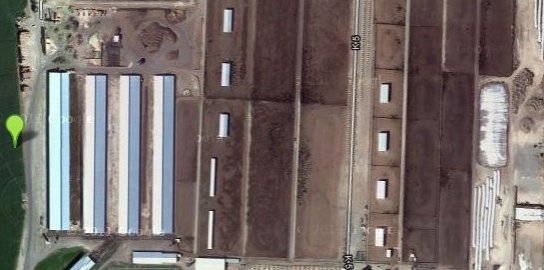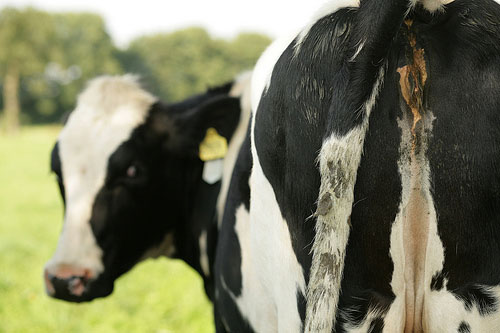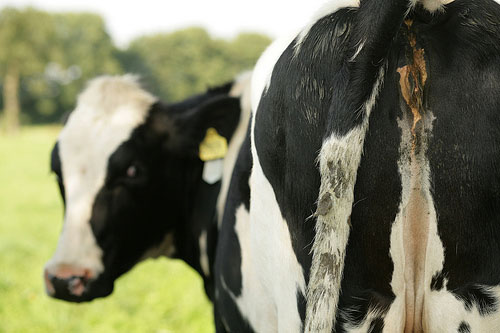
Aerial shot of the Nelson Faria Dairy in Royal, Wash. Note the tiny dots that are the dairy cows congregating in the holding pens. (Image by Google Maps.)
In a precedent-setting decision earlier this month that received scant national coverage, a federal district court judge in Washington state ordered a CAFO (Concentrated Animal Feeding Operation), also known as a factory farm, to monitor groundwater, drainage, and soil for illegal pollution resulting from its grossly inadequate manure management practices in violation of the Clean Water Act. This first-ever ruling holding a CAFO accountable for its pollution was a result of a lawsuit by the nonprofit Community Association for Restoration of the Environment (CARE) against the Nelson Faria Dairy in Royal, Wash. The ruling upholds the terms of a 2006 settlement CARE had with the dairy’s previous owners, which the current owners subsequently ignored.
The case underscores one of the major problems with CAFOs, which is the massive amount of manure they produce and the manners by which operators dispose of it, which have major environmental implications. According to the EPA, “a single dairy cow produces approximately 120 pounds of wet manure per day,” which is “equivalent to that of 20-40 people.” The quantity of manure produced by one dairy cow can be multiplied on a CAFO by hundreds or, in some cases, thousands of heads. This higher concentration of CAFO animals leads to a higher concentration of animal waste, a problem that holds true for all types of livestock raised in these operations. As CARE describes the scale of the waste problem:
Operations like the Nelson Faria Dairy produce as much waste as a city of over 200,000 people. Unlike cities, however, which treat their wastes, the dairy industry applies manure to agricultural fields primarily to get rid of it.

Photo by Tonvolz.
In moderation, manure is a great soil fertilizer, but the sheer amount (and concentration) of untreated waste generated by CAFOs is a serious liability. When too much manure is spread out over fields for soil to properly absorb it, or when manure lagoons leak, overflow, or rupture, rain and stormwater runoff can carry the waste into groundwater and nearby waterways. This over-application or discharge of CAFO animal waste is an egregious example of nonpoint source pollution, where the source(s) is diffuse and can have a wide distribution area. Untreated animal waste is a hazard for both public health and ecosystems because it can contain harmful quantities of nutrients, pathogens, and heavy metals. (Ecocentric has covered the problems associated with large amounts of untreated CAFO animal waste.)
The case of the improper handling of manure on the Nelson Faria Dairy is typical of the CAFO industry. While state and federal animal waste rules exist, their enforcement is lax at best. As CARE president, Helen Reddout, explained:
The Washington Department of Agriculture had recently inspected the dairy and found that it was doing an excellent job managing its manure. Nothing could be further from the truth … It is now time for the agencies who are supposed to be protecting our health to follow the precedent set by this Order. Our state and federal laws were aimed at protecting people and now it’s time for the agencies responsible for safeguarding public health to do just that.
Reddout goes on to explain the reality of state agency CAFO inspections:
Washington Departments of Ecology and Agriculture (WSDA) are supposed to monitor and regulate the dairy industry to ensure that operations do not harm public health or the environment. Unfortunately, inspections often involve nothing more than cursory visits by WSDA staff. If problems are found, dairy owners receive only a slap on the wrist, at best.
The hope is that this court victory against CAFO manure handling and pollution — little mentioned in the media — will help set a precedent toward better practices, regulation, and enforcement of the CAFO industry. Reddout acknowledges that this court victory is one small step, albeit an important one, that shows that CAFOs aren’t above the law and puts them on notice for pollution practices, a particularly big deal for the economically (and thus politically) strong Yakima Valley dairy industry. Based on the compelling evidence of agricultural water contamination in the Lower Yakima Valley, and bolstered by the recent ruling, the EPA selected the area for inclusion in a study monitoring nitrate pollution in groundwater. Reddout expects the EPA report to be released in late spring 2012.
CARE and their allies in the Royal City area deserve our congratulations for this major legal victory that may ultimately inspire a regulatory approach to CAFOs capable of safeguarding human and ecological health. Government agencies must acknowledge the great harm cased by CAFO pollution and hold the industry accountable for the true costs CAFOs impose upon the public.
As expressed by CARE’s lead attorney, Charlie Tebbutt, “Citizens have once again proven that the CAFO industry is a huge polluter. It is time for the state agencies to step up.”
To find out how many CAFOs are in your area, check out Food & Water Watch’s Factory Farm Map.
This post originally appeared on Ecocentric.



